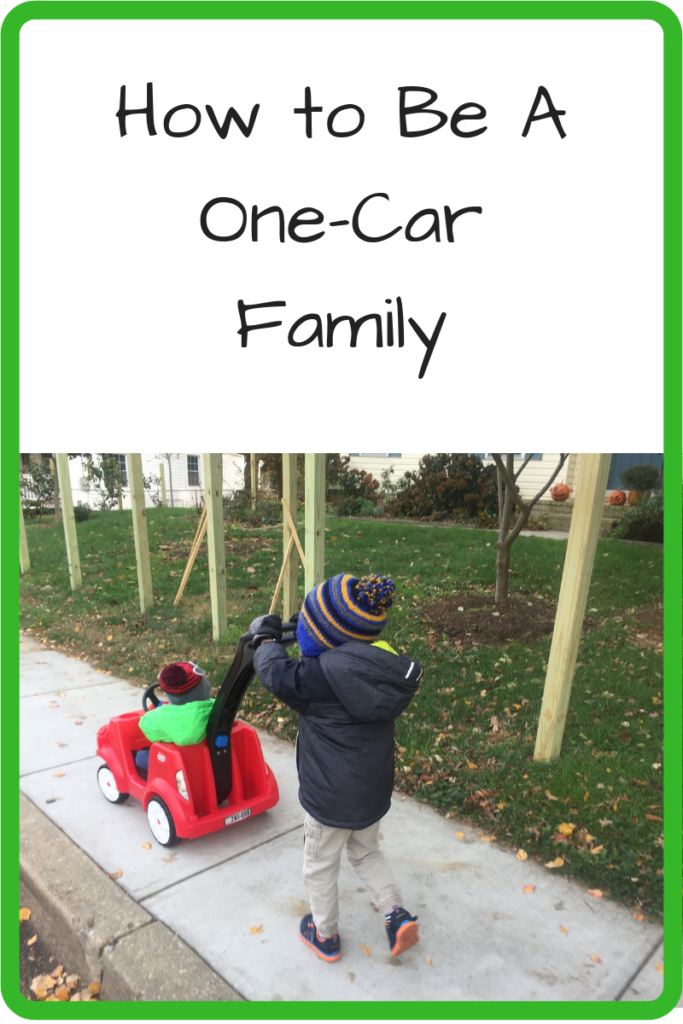
“How close is this house to the bus stop?” I asked the realtor as we looked for our house. While that’s not a typical question, it was essential for us. That’s because we only have one car.
People claimed that we’d have to buy a second car once we had kids – especially living in the suburbs. But even after having a second kid, we’ve managed to get by quite happily as a one-car family. It’s even possible to be a zero-car family – one of my friends has four kids and doesn’t own a car! Even if you own a second car now, you may want to consider not buying another one when you retire it. According to AAA, the average family spends $8,500 per car each year on payments, insurance, and gas.
If you’re going to make the leap – or just use the second car less – here’s what to consider:
Explore biking and walking places
You may be able to bike or walk more places than you realize! Look into how many of your frequent destinations can be reached by walking and biking, whether that’s the school or the grocery store.
For most people, walking half a mile to a destination will take about 10 minutes – a negligible time compared to how long it takes to drive and park. Obviously, it can take longer with small children, but then so does buckling kids into car seats.
Taking a bike expands your range even further. Biking two or three miles to a destination is reasonable for most people, even kids. I have fond childhood memories of biking to the local ice cream place with my parents.
Of course, walking and biking places isn’t just about distance. You also have to evaluate the safety aspect. Check out walking and biking routes on Google and then confirm them yourself on a day there’s no time pressures to get somewhere.
Get the right equipment
If you’re going to be walking or biking a lot, you want equipment that will meet your needs.
For walking, a good pair of shoes and a suitable stroller should be enough. Be sure to get a stroller with a good turning radius that can hold up to the bumps of uneven sidewalks. It’s also very handy if it folds up easily, so you can bring it on buses or into restaurants.
Biking gets a more complicated. Traditional back-mounted bike seats for kids will suit some families, but can cause balance and center-of-gravity issues. Many people love front-mounted bike seats for really little kids. If you’re going to be biking a lot with your kids, some of the best (albeit expensive) options are trailers and cargo bikes. Some kids don’t like trailers and cargo bikes are pricey, so it’s worth checking out the range of options before buying. Two Wheeling Tots and Rascal Rides both have great reviews of various types of equipment for family biking.
Evaluate your access to public or shared transportation
For destinations that are further away, you’ll probably want some motorized options.
Subway systems can be amazing in their speed, but many cities have very limited or no subway routes. While bus systems are often maligned, technology has led to huge improvements. Many buses now have built-in GPS that allows you to use an app to know exactly when the bus will arrive at your stop. Some fancier stations even have signs that display when the next bus is set to arrive. There’s also been a huge amount of growth in “express” bus routes to major transportation centers. Because the routes only have two or three stops, these are often almost as fast as driving. The nice thing about public transit is that you can do something else while you’re on route, such as reading a book or playing a game with your kids. My kids love taking the bus or train.
Another alternative is car-sharing, such as Zipcar. These programs let you rent a car for a very short period of time, making it cheaper than a daily rental. Car-sharing programs can also expand the types of cars you have access too. Some programs have SUVs and pick-up trucks available, which are handy for hauling things to the dump or bringing furniture home.
If you’re worried about reliability, many county transportation programs offer a “guaranteed ride home” where they’ll pay for public transit riders to take a taxi or other form of transportation in emergency situations. It’s usually free to sign up.
Coordinate schedules
Having only one car won’t work if both adults need the car at the same time. Arrange your day-to-day schedule so the person who needs the car more often has access to it. In our house, my husband is a stay-at-home dad, so he has the car. I have the responsibility for getting myself back and forth from work. At the same time, the person with more access also gets more responsibility for running errands! If the schedule changes or there’s something you need the car for, discuss it with plenty of time to spare.
Make your car as versatile as possible with still being fuel efficient
The first time Christmas came around after our second child was born, we faced a dilemma. How were we going to cram all of our travel stuff and the presents into a Prius with two car seats? The solution – a roof rack. Since then, we’ve also used it to haul our camping gear around. It’s been a game-changer.
Getting the right equipment allowed us to get more use out of our current car without buying a second one or having to get a bigger one. Other features like fold-down seats can maximize the versalitity of a single car.
While sometimes having a single car is inconvenient, I’ve never regretted not getting another one. Between the money we’ve saved and the side benefits of active transportation like getting exercise, being a one-car family works for us!